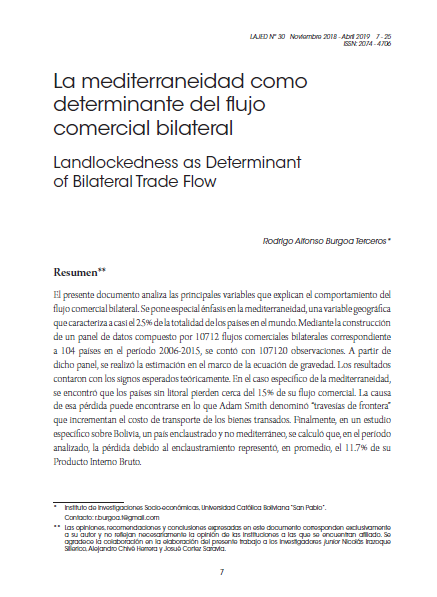The Landlockedness as Determinant of Bilateral Trade Flow
DOI:
https://doi.org/10.35319/lajed.20183012Keywords:
Landlockedness, cloistered country, bilateral trade flow, gravity equation, transport costsAbstract
This paper analyses the main variables which explain the behavior of bilateral trade flows. Special attention is payed to landlockedness, a geographic variable that characterizes to almost 25 percent of all countries around the world. Through a panel data composed by 10712 bilateral trade flows corresponding to 104 countries in the period 2006-2015, 107120 observations got available for the econometric model. The estimations were run in the framework of gravity equation. The results showed the signs expected theoretically. In the specific case of landlockedness, it was found that countries with this characteristic, lose about 15 percent of their trade flows. The cause of this loss can be found in what Adam Smith called “border crossings”, which raise the transport costs of good exported or imported. Finally, in a specific study about Bolivia, a cloistered country and not a landlocked one, it was calculated that in the analyzed period, the loss due not counting with sea coasts represented about 11.7 percent of its Gross Domestic Product.
Downloads
References
Anderson, J. 1979. “A theorical foundation for the gravity equation”. The American Economic Review, 69 (1), 106-116.
Anderson, J. y E. van Wincoop. 2004. “Trade costs”. Journal of Economic Literature, 42 (3), 691-751.
---------- 2003. “Gravity with gravitas”. The American Economic Review, 93 (1), 170-192.
Asociación Latinoamericana de Integración. 2016. “El costo de la mediterraneidad: Los casos de Bolivia y Paraguay”. Programa de apoyo a los PMDER, 216, 1-44.
Bergstrand, J. 1989. “The Generalized Gravity Equation, Monopolistic Competition, and the Factor-Proportions Theory in International Trade”. The Review of Economics and Statistics, 71 (1), 143-153.
---------- 1985. “The Gravity Equation in International Trade: Some Microeconomic Foundations and Empirical Evidence”. The Review of Economics and Statistics, 67 (3). 474- 481.
Brue, S. y R. Grant. 2009. Historia del pensamiento económico. Ciudad de México, México: Editorial CENGAGE Learning.
Chandra Paudel, R. 2014. “Economic Growth in Developing Countries: Is Landlockedness Destiny?” Crawford School of Public Policy, 2014 (1), 2-37.
Deardorf, A. 1995. “Determinants of Bilateral Trade: Does Gravity Work in a Neoclassical World?” National Bureau of Economic Research, 5377, 1-30.
Faye, M., J. McArthur, J. Sachs y T. Snow. 2004. “The Challenges Facing Landlocked Developing Countries”. Journal of Human Development, 5 (1). 31-68.
Gallup, J., J. Sachs y A. Mellinger. 1998. “Geography and Economic Development”. International Regional Science Review, 22 (2). 179-232
Helpman, E. y P. Krugman. 1985. Market structure and foreign trade. Cambridge: MIT Press.
Hotelling, H. 1929. Stability in competition. The Economic Journal, 39 (153), 41-57.
Isard, W. 1954. “Location theory and trade theory: short-run analysis”. The Quarterly Journal of Economics, 68 (2), 305-320.
Manzano, N. 2012. El costo de la mediterraneidad en Bolivia. Cochabamba, Bolivia: Instituto de Estudios Sociales y Económicos.
Organización Mundial de Comercio. 2012. A Practical Guide to Trade Policy Analysis. Ginebra, Suiza: OMC.
Real Academia Española. Diccionario de la lengua española. Disponible en: http://dle.rae.es/?id=OmN5Uwq Recuperado el 12 de julio de 2018
Samuelson, P. 1954. “The Transfer Problem and Transport Costs, II: Analysis of Effects of Trade Impediments”. The Economic Journal, 64 (254), 264-289.
Smith, A. 1776. Investigación de la naturaleza y causas de la riqueza de las naciones. Valladolid, España: Santander.
Venables, A. y N. Limao. 1999a. “Geographical Disadvantage: A Heckscher-Ohlin-von Thunen Model of International Specialization”. Banco Mundial, 2256, 1-38.
---------- (1999b.). “Infrastructure, Geographical Disadvantage, and Transport Costs”. Banco Mundial, 2257, 1-48.






